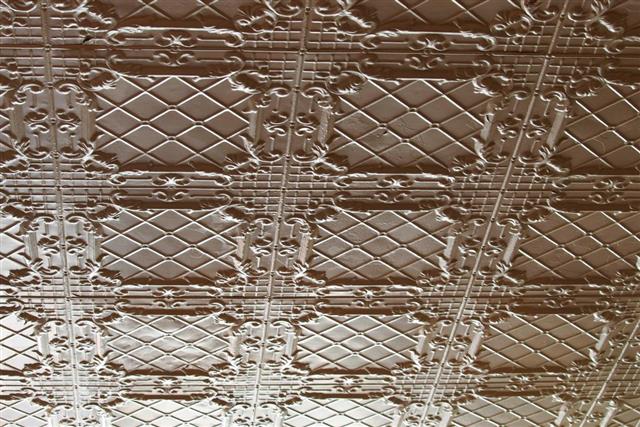
Tin ceiling tiles are making a comeback these days in home décor. If you are thinking of making home improvements using these tiles, here are a few ideas.
Are you getting tired of your stained and drab old ceiling? Why not go in for one of the latest trends in home improvements these days, and replace your old ceiling with tin tiles. Not only are they attractive but you do not have to go to the expense of hiring somebody else for the job, since they are easy to install and can be a DIY job.
A Peek into the History of Tin Ceiling Tiles
Actually tin ceilings are not a new idea but have been around since the mid 19th century, when they were indeed an innovative idea. In those days, tin tiles were used by the middle class of America as an answer to the decorative plaster ceilings, which the wealthy Europeans used heavily. Tin ceiling tiles at that time were mass produced easily, light to work with, had intricately detailed designs, and were superior to plaster in several ways. These embossed tin panels were used to cover the ceilings of hotels, businesses, and homes.
That trend in tin ceiling tiles topped out in the 1890s, after which much of that ornamentation was covered up with acoustic drop-ceiling tiles or drywall. It was much later when experts in restoration began returning homes to their previous grandeur that the preserved tin ceiling tiles were again uncovered. Although some of them needed a certain amount of repainting, stripping, or mending, much of the old tin ceiling tiles did manage to withstand the ravages of time and mishandling far better than was expected.
Renewed Interest in Tin Ceiling Tiles Today
These days, tin ceiling tiles are back in fashion, making a considerable come back in home décor. Remodelers are being swamped with the demand of homeowners for tin ceilings for their home improvement projects. Builders are using them as a sales incentive in many of their new models of homes. Designers too are greeting this new trend in these ceiling tiles with great enthusiasm. Many companies have started recreating these tiles in the same patterns that were popular in the past with renewed interest. This nostalgic yearning for that era of America has made it possible for antique, copper, and silver finishes of those old designs, along with customized designs to suit the modern home décor trends of today.
Many of the designers of today still continue to paint tin ceilings in white to make it look like plaster, however, the original tin look is catching on now, since many people want to emulate the style of the 1800s.
Varied Designs: Instead of using the lightweight grayish colored aluminum or economy tin, it is a better idea to go in for the unfinished tin panels, which are made with bright tin plated panels that are steel stamped. These tiles are available in various types, colors, and patterns. As far as colors are concerned, they are available in shades of gold, black, silver, rust, burgundy, copper, mocha, bronze, and white. If you use unfinished tiles, you can paint them according to your choice of colors; or if you do choose colored tin tiles, you can use a clear polyurethane coating as a protective cover. When using tiles that can be snap locked, they can be anchored directly to a drywall ceiling using 6 drywall screws.
Using Backsplash Tin Ceiling Tiles: Backsplash tin tiles are growing in popularity for kitchens and bathrooms. Tiles that have the six-pattern style are more appropriate for creating this effect, although 12-pattern tiles are also used. These tiles have to be nailed up rather than being snap locked.
Using Colored Tin Ceiling Tiles Appropriately: Using light colored tin ceiling tiles in a room that has a low ceiling helps to reduce the low-ceilinged look. If you are planning on renovating your bathroom’s ceiling with these tiles, you can opt for bolder colors. Burgundies and mochas look great in living rooms. Of course, it goes without saying that ultimately it is your personal taste in color as well as the style of interior decoration of your home that will matter most.
Tin tiles can add a fresh touch to an old and stale room without costing too much and with the ability of easy installation.





